Jan - Mar, 2005
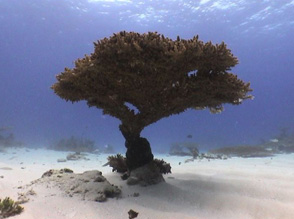
Nukufetau is an atoll with many islets, 'motus' surrounding a central lagoon. There is a fringing reef outside the lagoon and patchy coral cover inside the lagoon, mostly in scattered bommies. The lagoon floor is soft sand. Inside the lagoon there are also some areas of denser coral growth with large patches of staghorn and table Acropora colonies.
The majority of data was collected close to the main pass into the lagoon, although observational dives were made at other locations.
The water temperature inside the lagoon (measured from the RV Heraclitus) ranged between 28.7°C and 30.6°C
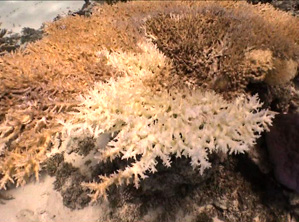
Eight point nine percent (outside the atoll) and 6.8% (inside the atoll) of the areas studied were affected by bleaching.
The genus showing the most common incidences of bleaching was Acropora but Pocillopora and other colonies were also sometimes affected. However, both inside and outside the lagoon there are numbers of table Acropora colonies which have died within the last few years. It is possible that this was caused by a significant bleaching event a few years ago.
There were no visible signs of disease.
Outside the lagoon, we observed visibility up to 30 metres. Inside the lagoon, the visibility was generally lower, averaging around 15 metres, depending on whether the tide was coming in or going out.
Vertical measurements showed visibility to 25 meters depth.
Fewer than five observed over course of all dives in Nukufetau, inside and outside lagoon.
Nukufetau is an island of the Tuvalu group. Once part of Kiribati these islands became independent in 1975. There are five coral atolls and four islands, a small nation (the fourth smallest in the world) with only 26 sq km of land spread over 800 km of ocean. The islands lie 1100km north of Fiji and 250km south of Kiribati.
Nukufetau lies approximately 45 miles north-west of the capital Funafuti. Nukufetau has a population of approximately 700 people, although this number is reduced when school children leave for Funafuti. Many islanders work in the capital or overseas, especially as seamen.
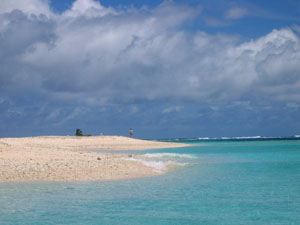
The lagoon has two natural entrances on the west side. One of them is used frequently by the cargo/passenger ships that travel between Funafuti and the other islands of Tuvalu, having loaded cargo from Fiji.
Although Tuvalu is considered to be outside the cyclone belt there have been increasing occurrences of cyclones passing over the islands in recent times, due to disturbances in global weather patterns. We were anchored in either Nukufetau or Funafuti from end of December 2004 to end of March 2005 and in that time encountered rough storms (with winds gusting over 40 knots) which developed shortly after in cyclones.
Tuvalu is currently at the centre of a debate regarding global warming and the future of many oceanic islands. Should sea levels rise at the alarmingly steep rate predicted, the entire country of Tuvalu is threatened to be submerged since none of them stand higher than 5 metres above sea level. But before that eventuality, drinking water supplies will be ruined and the islands will become uninhabitable.
We studied mainly on the northwestern edges of the lagoon where breakers sometimes crash over the sandbar and ‘one-tree’ island when the wind is blowing from the west. There are large clusters of coral dominated areas close to the edge, with increasingly large areas of sand as one moves towards the middle of the lagoon. Eventually the bottom slopes off to sand as it gets deeper (up to 35 metres). There are several shallow patches in the middle of the lagoon, including one very interesting site just southeast of the entrance through the main pass where large amounts of fish gathered. These patches are clearly visible in daylight.
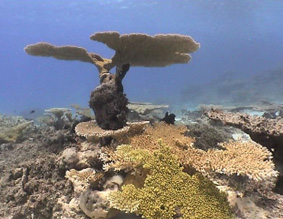
Outside the lagoon, there is a shelf stretching most of the north-west edge of the atoll at about 10-15 metres depth. From here the reef slopes at first gradually and then drops off more steeply. On the westernmost point, there are signs of storm damage - large coral plates shattered by heavy wave action that comes with the westerly winds during the cyclone season. We dived here after we had encountered several storms ourselves and could see freshly shattered corals.
The pass itself is shallow in parts – under 10 metres. At the entrance to the past there is a large sandbar on the bottom, then ridges develop that follow the length of the pass. There are healthy hard corals on these ridges with rock valleys running in between them.
At the second, and smaller, pass into the lagoon there are very large Acropora table formations. The most elaborate hard coral formations are inside the lagoon to the north – the most protected area of the lagoon.
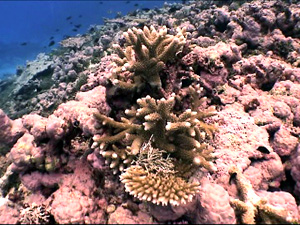
We observed considerable amounts of coralline algae overgrowing scleractinian corals, mostly in the pass and outside the lagoon.
There is a substantial amount of sedimentation occurring inside the lagoon, as is to be expected inside a large lagoon with wave action rolling in from outside.
Both inside and outside the lagoon, we observed many dead table Acropora colonies. The skeletons were still intact and overgrown by algal turf in most cases, indicating that they had died quite recently. Upon arrival to Funafuti in March, we learnt of bleaching observations made during November 2004, higher incidences of bleaching than we observed. It is possible that there was a significant bleaching event here recently and that we observed the tail-end of this event.
Inside the lagoon, there are scattered shallow patches where fish gather around the corals for feeding. Along the edge of the lagoon, close to the main pass, there are healthy numbers of fish for the amount of coral coverage, including plenty of groupers, emperors and some snappers.
In the pass itself, we dived with sharks and manta rays, depending on the tide.
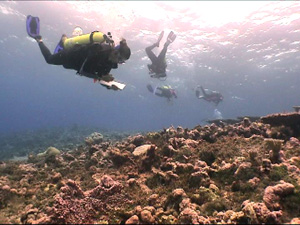
Outside the lagoon there are healthy fish populations including the top predators (grey reef and blacktip sharks, red snappers, black snappers), but there seemed to be a lack of large schools of fish in general at Nukufetau. On the western point where currents meet, we observed a large school of rainbow runners and many turtles. We also encountered spotted eagle rays several times.
We were told that schools of big-eye tuna used to run into the lagoon. We didn’t see any. Twice we encountered large schools of big eye trevally but no large schools of snappers. It would not have been surprising to find a lot more fish in the pass and outside the lagoon, considering the state of health of the coral cover.
It is possible that there has been overfishing in Nukufetau. In several of the islands of Tuvalu, fish refrigeration systems were set up to encourage fishermen to store their catch for shipping on the cargo boats to Funafuti. The operation at Nukufetau appears to be inoperable now. But the Tuvalu economy is 20% supported by the sale of fishing rights for its EEZ (900,000 square kilometers) – more than 80% of these sales in 1999 were to US purse seine fishing fleets. Also Japan, Korea and Taiwan. In recent years there has been an increasing amount of foreign fishing activity in Tuvalu. In 1999 more than 40,000 tons of fish were caught by vessels registered in six countries. Vessels from the USA and Japan accounted for more than 99% of the catch, mostly skipjack and yellowfin tuna. The Tuvaluans themselves catch and consume about 1,000 tons a year.
In Funafuti, at least, there was a sea cucumber harvesting industry that has not yet been revived. Some areas of the lagoon had substantial populations of sea urchins but not at our study sites.
There are a healthy number of clams on the reefs inside and outside the lagoon. We observed clams in most places that we dived but there are few to be found above 10 metres.
Many corals, especially outside the lagoon, are afflicted by bioerosion. Astreopora is particularly affected by boring mussels.
During our time in Nukufetau in January, we encountered a pod of spinner dolphins in the pass and just outside the pass several times. They were very approachable and spent time with us in the water. On our return to Nukufetau in February/March, we only met the dolphins once inside the lagoon and for a very brief time. In general, there are plenty of turtles outside the lagoon, both hawksbill and green turtles.

This is a timely study for the reef of Nukufetau. Right now there is no sign of drastic damage through waste – either by chemicals or plastic trash. The most imminent threat to the reef of Nukufetau is the proposal to reconstruct the airport. There was an airport built on the southwest strip of the atoll during World War 2. It is possible that this airport will be redeveloped and the Tuvaluan capital, including all government offices, relocated from Funafuti to Nukufetau. This has many major implications. The construction and development process will involve drastically increased shipping traffic in and out of the lagoon. Trees would have to be cleared, fuelling and docking facilites built. Homes and offices would be built. These processes in themselves would affect the reef, but also the increased population on Nukufetau would have drastic affects.
It is very questionable that the lagoon of Nukufetau could sustain this activity. Funafuti has a significantly larger lagoon with many more channels allowing water to pass in and out. Nukufetau has only two small passes. For most of the year, when the wind blows predominantly from the southeast, the southeast part of the atoll is solid land with no flushing of the lagoon water possible. It’s only during the cyclone season when the winds are shifting that extra water movement can occur. The airport site is in the southwest corner of the atoll where the water is very stagnant because it is protected from wind and currents.
Island resources would be strained, possibly beyond limits. The only fresh protein resources on the island are fish and pigs. There are gardens for bananas, coconuts, papayas and bulaka (a type of taro) but should construction affect these gardens, then nearly all of the food required would have to be imported.
There used to be many traditional ways of managing the reef resources. For example, the chief would open and close areas of the atoll, for fishing, coconut crab hunting etc. Nobody was allowed to make a personal profit from marine resources – it was obligatory that these resources were shared so distributions were made to the head of each family. Even during our time here, we witnessed part of this tradition as a large catch of rabbitfish was counted and divided among the families of the island.
There were no freezing capabilities so all catches were subsistence, with some for salting and drying. The heads of the tuna were thrown back in front of the pass of the lagoon to attract fish into the lagoon. The shavings of coconut after milking them were not given to the pigs but thrown back into the lagoon to feed the fish. So in recent years there has been a shift in the management of the island’s marine resources.
This proposal appears to spell potential disaster for Nukufetau. The majority of the profits would pass to foreign construction companies and developers. Very little of it would actually pass to the community. And the community would struggle to maintain their resources and their lifetsyle which until this point they have managed very well.